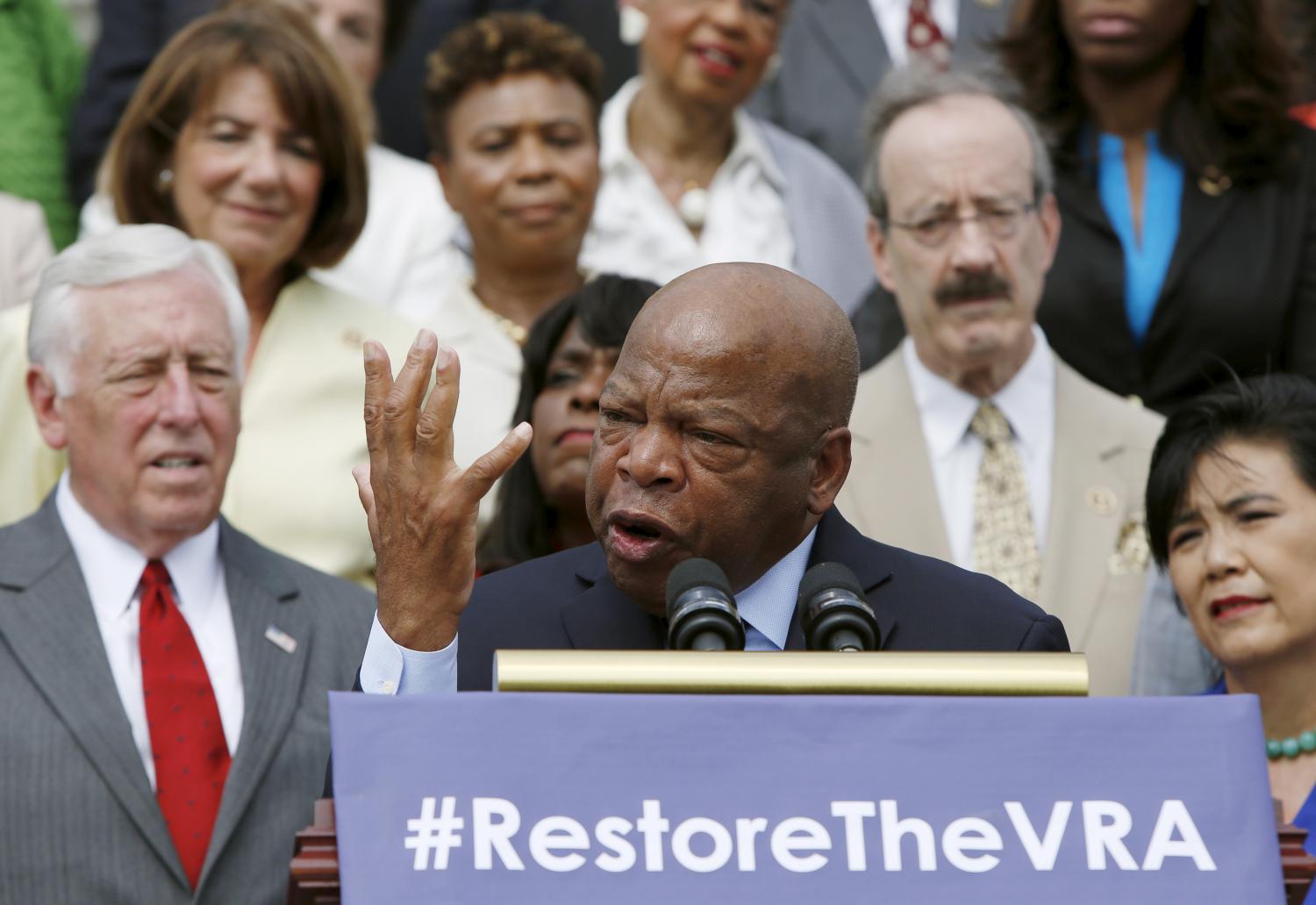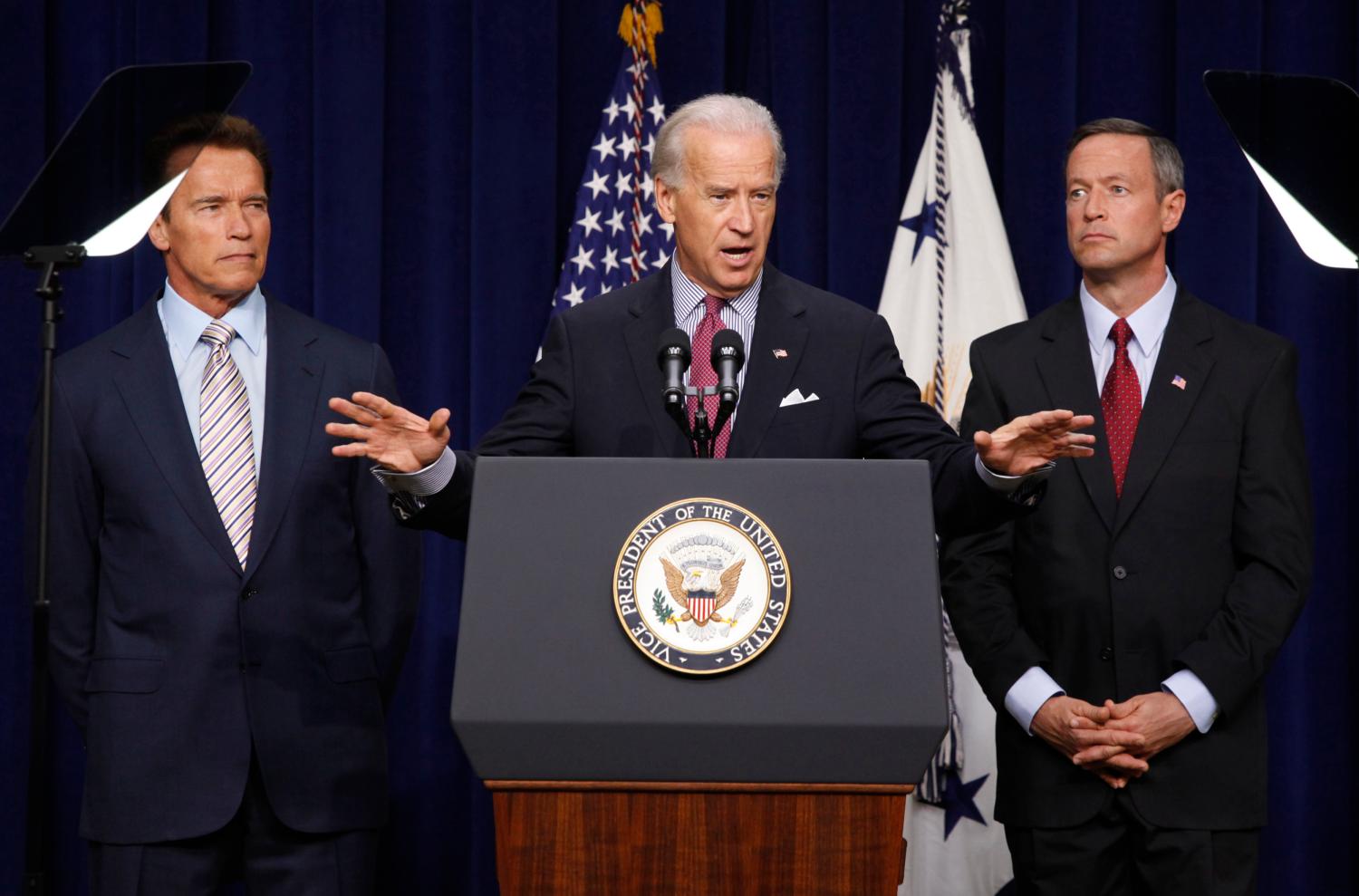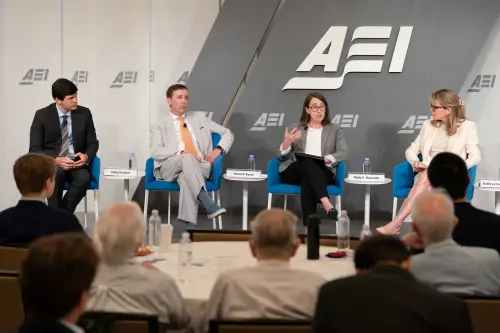Pietro S. Nivola joined Brookings as a scholar in 1988. He served as director of the Governance Studies Program from 2004-2008, retired in 2013, and remained an esteemed senior fellow emeritus until his passing on April 5, 2017. This essay, which Pietro wrote in memory of his colleague Martha Derthick (director of the Governmental Studies Program at Brookings from 1978 to 1983) is his last Brookings publication. A longer version of this piece was published in the Winter 2017 issue of Publius: The Journal of Federalism.
Introduction
Observers of American federalism have long debated its distinctive vices and virtues. But at least one distinction remains beyond dispute: the system’s complexity. That general characteristic was of considerable concern to the late Martha Derthick, the distinguished scholar to whom the Winter 2017 volume of Publius was dedicated. Derthick was at pains to remind us that the Framers had fashioned for the United States not a simple federation but rather a unique “compound republic”—one that, in her words, has proven “a very confusing form of government, with authority diffused and obscurely allocated.”1
The following essay discusses various complications besetting this federated regime over time, including ones Professor Derthick duly examined but also some she had not, and later considers their political implications.
Old predicaments
Let us start with what hardly anyone can deny: state and local authorities at times have faltered woefully in meeting government’s basic responsibilities.
Let us start with what hardly anyone can deny: state and local authorities at times have faltered woefully in meeting government’s basic responsibilities. These include: managing conflict; providing certain essential, often costly, public goods; protecting fundamental rights and liberties; securing a suitable safety net for persons in need; and effectively regulating economic activities that may spill detrimentally across jurisdictions.
Conflict management. A presumed advantage of federation in lieu of unitary rule is that it offers a country’s diverse regions, with their varying preferences, a measure of self-government. Sometimes permitting regions to federate and partially govern themselves does mitigate sectional strife. Indeed sometimes it appears to be the only institutional refuge against separatism. But not always. Through much of its history federalism in the United States did not ease sectional tensions. On the contrary, at times the institution looked more like a springboard for secessionism. A long sequence of compromises with the sovereign Southern states, from the era of the founding through the first half of the 19th century, failed to prevent the Civil War.
Public goods. A glaring defect of the Articles of Confederation had been the inability of the original thirteen former colonies to provide adequately for the common defense, the quintessential case of an essential and expensive public good. Perhaps less widely recalled is that more or less the same deficiency persisted into the 19th century, well after the Constitution with its stronger union had been ratified. The United States was still relying substantially on state militias to wage the War of 1812, for instance. Some of the militias were effective, others proved incompetent, and still others were unwilling to engage at all. The result came close to being fatal.2 Full recognition that the nation could not entrust its security largely to volunteer forces mustered at the behest of the several states took decades to sink in.

Securing rights and other essentials. Were Martha Derthick still with us to peek at this paper she undoubtedly would be quick to agree that as with collective goods (whether the example is provision of the national defense or construction of a coordinated network of highways) so with upholding civil rights, ensuring a sound social safety net, and regulating health hazards that cross state lines: a mere state-by-state approach would too often fall short.
Historically, because defaulting to it could beget local abuses, inertia and freeloading, a strictly state-based agenda would eventually give way to a logical corrective: less federalism. By 1964 a national Civil Rights Act ultimately had to be summoned to meet the resistance of states in the South which were enforcing racial apartheid far into the 20th century. The New Deal was invoked in large part because most states had been unable to rescue their impoverished inhabitants from the Great Depression. The nation’s Clean Air and Clean Water Acts might have been less necessary if the states, acting independently, had managed to curb extensive pollution that moved past their respective borders. (Unless otherwise encouraged, a community whose contaminated air or water flows downstream to other places has little incentive to stop the cross-border spillover for their sake.)
Derthick would be the first to recognize that such shortcomings of local control stem not infrequently from a basic difficulty Madison had identified in Federalist 10: a propensity of small polities to be captured by entrenched interests. Would a one-company town crack down on a factory that happens to be a wide-ranging polluter but also the local economy’s mainstay? Prior to, say, 1954, were recalcitrant state governors and legislatures, left to themselves, prepared spontaneously to desegregate schools? Even now, can individual states and localities, which must compete for investment (hence keep progressive tax rates in check) and avoid degenerating to welfare magnets, be especially eager to redistribute wealth to needy households?3 In no small degree, performing roles like these has posed a challenge for society’s sub-national governments if left entirely to their own devices. The remedy, of course, has been for the central government to add inducements and regulations aimed at overcoming the local derelictions.
New difficulties
The seemingly neutral label for this federal intervention is “cooperative federalism.” What may have sounded straightforward in principle, however, has grown complicated in practice. In the modern era there has been an accretion of intergovernmental strictures (mostly attached to the main levers for “cooperation,” conditional grants-in-aid). The extent of these requirements and restraints, often remarkably intricate, is worth contemplating.

Consider the following brief sample of mundane local concerns affected by national legislation, regulations, or court cases. As is well-known, federal lawsuits have reached deep into local employment practices and modes of personnel management. Less visibly, federal law touches other routine matters. How many local taxpayers realize, for example, that it can have a bearing on what they have to pay for everything from snow removal to contracts to construct federally-mandated sidewalk ramps? What protective measures must be taken to secure local landfills, school buildings that may contain asbestos, and proper removal of lead paint from housing units, are no longer outside the orbit of federal prescriptions. Neither in quite a few places are the requisite procedures for, say, deploying firefighters at a burning building.4 Federal regulations require public schools to provide an individualized education plan for each student with a disability. There is a statute that now weighs in when states issue common drivers’ licenses. Federal rules even tell passengers where it is safe to stand onboard a municipal bus (“standees” are forbidden to be in “a space forward of a perpendicular plane drawn through the rear of the driver’s seat and perpendicular to the longitudinal axis”).5
So much comingling of central tutelage with local affairs is not always easy to understand. Should a national cabinet department or regulatory agency really be dealing with how “standees” ride city buses, or with the deployment of a community’s firefighters?
So much comingling of central tutelage with local affairs is not always easy to understand. Should a national cabinet department or regulatory agency really be dealing with how “standees” ride city buses, or with the deployment of a community’s firefighters? Can’t local transit authorities and fire departments be left to decide such particulars?
A thorough explanation of why lines between national and local purviews became blurred would take us far afield. For present purposes suffice it to say that Professor Derthick was among the leading political scientists who shed light on the question. Her work explored how federal initiatives acquired uninhibited vested interests (at both the bottom as well as the top); how new policy entrepreneurs and spirited litigants were empowered to breach old boundaries; how, striving to enhance accountability, programmatic “strings” grew lengthy and dense; how the judiciary (federalism’s arbiter) increasingly facilitated a widening agenda; in sum, how one thing led to another.6
“The federalism that the United States has today,” [Derthick] reckoned in one of her last essays, “is not the federalism that James Madison foresaw.”
Derthick’s insights into these political dynamics were instructive, but no less so was her assessment that although our traditional framework of federalism has enduring features (including the obvious fact that “the states are governments in their own right” and have always been tasked with performing most of the country’s administrative duties) the federal system has also undergone big changes.7 “The federalism that the United States has today,” she reckoned in one of her last essays, “is not the federalism that James Madison foresaw.”8
Whatever else federated governance is supposed to do, it is meant to maintain some semblance of a division of labor between levels of government. To be sure, every federation struggles to delineate a viable demarcation of tasks. For decades the European Union has tried to define subsidiarity, aspiring to arrange respective competences sensibly, but it continues to show uneven results. In America, the 10th Amendment was supposed to give guidance, and for a time the Supreme Court labored to sustain a doctrine of “dual federalism.”9 Both have had a tortured history. At first the court strained to defend state sovereignty, even opining rigidly that Congress could not regulate the products of child labor.10 Later the justices would relent, to the point of enabling the grain a farmer grew just to feed his own livestock to become fair game for federal regulation under the commerce clause.11 As for the 10th Amendment, it eventually was shrugged off as but a “truism.”12
The inherent frustrations notwithstanding, there is a case to be made for seeking, to borrow Derthick’s phrase, something like a more “stable set of understandings about how to distinguish the national from the local.”13 Yes, our compound republic duly reflected “the complicated and ambiguous intent of the framing generation,” Derthick wrote.14 And of course there is no way of knowing how emphatically James Madison would have objected to the regime’s modern form with its tangled intergovernmental relations. But surely this new political order seems a far cry from the model Madison envisioned; he expected that “local and particular” issues would be the business of the states, whereas the focus of policymakers in the capital would be the nation’s “great and aggregate interests.”15
This transformation has had a variety of consequences, including some confusing ones. I will come to a few of them in a later section of this article.
A macro muddle
For all its altered attributes federalism in America retains vital advantages, not the least of which is what public finance economists call the concept of fiscal equivalence.16 In the United States, unlike in most other advanced countries, local taxpayers are still expected to pay directly for most of the local services they consume. True, grants and transfers from Washington account for a large share of resources available to states and cities. Yet even in comparison with other federal systems (such as Germany’s) the local needs or demands of citizens here still have to be met primarily through own-source revenues.
This arrangement furthers fiscal responsibility and local creativity. If a state or municipality desires better schools, roads, or social services, its residents to a significant extent—not some distant patron—have to pay the piper. To defray its expenses the municipality or state has to compete to attract taxpaying households and businesses. The interjurisdictional competition for jobs and wealth is often efficient. It spurs communities to experiment with public investments, regulatory reforms, and manageable healthcare and welfare programs that won’t impair the local economy and hence can bolster the local tax base. Because quite a few people and firms can “vote with their feet” jurisdictions may well have an incentive to pursue innovative policies but also, in fiscal terms, not to get too far out of line by embracing profligate agendas. The resulting local experimentation may eventually redound to the benefit of society as a whole. When considering new programs, policymakers at the national level presumably tend to learn “what works” from projects first field-tested in the states.
All this, not just in theory but in fact, is the good news. Our federated republic has encouraged a modicum of fiscal discipline. It has had a hand in restraining, albeit unevenly, the growth of a bloated public sector that overtaxes and overregulates. For commercial entrepreneurs the hurdles of starting a business in this country, and then of negotiating the labor market, are less intimidating than in a number of European countries. For all the excesses of some spendthrift state governments none has recently suffered a fiscal crisis comparable to, for example, those of various distressed EU member states.

Alas, however, the bad news is that the system also has the defect of its virtues. The economic crash that arrived in 2008 served as a painful reminder that a primary obligation of any modern government is to take anti-recessionary action, and to do so expeditiously, comprehensively, and efficiently. And this is where America’s two-tiered government sector, roughly half of which rests at the state and local level, was no asset. For therein, what may be virtuous constraints in normal times—chiefly the norms of fiscal equivalence and of balanced-budget requirements in nearly every state—can turn out to be liabilities in a severe economic slump. Why? Because they impel pro-cyclical policies that may partly neutralize the countercyclical efforts of the central government. So while Congress may deliver a fiscal stimulus, and the Federal Reserve pursues monetary expansion, states and localities have a tendency to move in the opposite direction: scrambling to meet revenue shortfalls, they cut budgets and raise taxes.17 On the margin the ill-timed austerity measures may have contributed somewhat to the fact that, month after month, recovery from the Great Recession remained anemic.
Martha Derthick did not probe this particular intergovernmental paradox—wherein during downturns the states effectively take money out of people’s pockets as Washington tries to put more in—but she did ponder more generally the hindrances federalism can pose for smooth policy implementation.
Begin with the basic reality alluded to earlier: state and local bureaucracies are the nation’s main administrators; the federal government administers few functions directly. “To achieve many of its domestic purposes,” Derthick emphasized, “the federal government relies on local governments.”18 The reliance on them can become problematical for at least two reasons. First, to gain local cooperation the feds not only have to wield ample incentives but also possess granular “knowledge” of how and where to aim them at targets that will achieve desired results.19 Even if such knowledge and precision were less limited than it ordinarily is, there are likely to be local polities that still say in effect “Thanks, but no thanks. Not in my backyard.” In recent years the Affordable Care Act has presented the most conspicuous case in point. (Many states simply declined to form their own health insurance exchanges, and many turned down the carrots that were offered to expand Medicaid enrollments.) But secondly, and no less important, typically too little tends to be known about effective targeting.

In part the saga of the American Recovery and Reinvestment Act (ARRA) was illustrative. With the country in the throes of the worst recession since the Depression, Congress enacted a massive economic stimulus package early in 2009. Portions of the bill were intended to aid state and local governments maintain essential services, and to bolster employment through a variety of infrastructural initiatives. Some of these efforts ran afoul of federalism. In quite a few places, as it turned out, not enough projects were sufficiently “shovel ready” to put ARRA dollars to work in time. Worthwhile investment ideas, like a multibillion-dollar plan for smart-grid development, were slowed to a crawl by local regulatory obstacles. By one estimate no fewer than 231 state and local regulators had to sign off on the modernization of grids.20
Overall, a year after passage of the stimulus legislation—and more than two years into the grueling recession—fewer than half of the states had spent down at least 60 percent of the total ARRA funds made available to them.21 This is not to conclude, as many critics claimed, that all told the stimulus was ineffectual. Some of the lag in state disbursements helped backload spending into subsequent years, when the economy still needed a boost. Only certain components of the stimulus had to wend their way through the states, and their rates varied significantly. Parts of the ARRA were quick-hitting. (Checks issued by the Social Security Administration, for instance, reached their intended recipients promptly.) Nonetheless there is little question that the stimulus experienced no small share of local vexations.
Governments around the world struggled to mount remedial macroeconomic policies when, eight years ago, timely and well-designed ones were urgently needed. Looking back, the United States actually began recovering sooner than a number of European countries did despite the political hurdles it had to clear. Still, if John Maynard Keynes could have borne witness, he likely would have been unsettled by some of those hurdles—not least the complicated exigencies of federal-state coordination. Quite plausibly Keynes would have suspected that, among other things, had it not been for federalism’s “fiscal drag” the U.S. recovery might have been a bit less tepid.22
Ordinary challenges
Big-time troubles like those encountered when the U.S. government had to contend with a major economic setback several years ago decidedly need to be considered when assessing our political institutions—including federalism. But tests as severe as the Great Recession are relatively rare (occurring perhaps once in a generation, if that). In normal life the average person faces pettier rigors—and state laws, with or without the federal government’s involvement, supply more than a few. Comparatively trivial though they typically may appear when taken individually, cumulatively they add up to another significant layer of legalities with which people have to cope.
Where to begin? To avoid a long and inevitably boring litany let’s just glance for a moment at three situations.
A person who earns income in several states that levy income taxes usually has to file returns and payments in each of the jurisdictions. Without the services of a skilled accountant the process of sorting out inter-jurisdictional taxation can be tedious and even tricky. At a minimum duly recouping credits from the various states to which payments were made, but in which the taxpayer does not permanently reside, requires a watchful eye.
Each year millions of Americans relocate to another state. The numbers can seem surprising considering the numerous legal intricacies that have to be handled when changing state residency. The to-do list for households includes everything from obtaining different drivers’ licenses, auto registrations, and insurance policies to, quite possibly, reworking healthcare plans, occupational licensing, school enrollments, and more. These items are often less simple than they sound. All considered, short of applying for a visa, the amount of paperwork can faintly begin to resemble what a household might expect when moving overseas.
There are, to be sure, understandable explanations for such technicalities. In the case of taxpayers subject to multi-state taxation an underlying factor is that each state is pressed to stake a claim on as much potential revenue as possible to help balance a budget. As a consequence even some out-of-state residents may end up feeling like they are being put through the wringer. More generally administrative vicissitudes—pertaining to portability or transferability of services like insurance (which is governed by diverse local regulatory regimes), additional federal mandates, variable reciprocity arrangements among states, and so on—beset the federal system.
Consider the obligation of a family, enforced in all states, to educate its children. Suppose you take up residence in a community close to a state line, and also posit that the best and most accessible school for your child happens to be situated nearby but across the line, in another state. In principle, using a system of reciprocal inter-state tuition or tax remissions, your home state could facilitate the matriculation of the child in the out-of-state school. In practice such accommodation depends on geographic happenstance. (School-enrollment reciprocity agreements have been negotiated among states, but they can be patchy. Minnesota, to take a random example, borders four other states. It has K-12 reciprocity with two of its neighbors but not all four.)
The main takeaway is: federalism makes demands of citizens. The demands have grown more detailed, though the tendency is an old story. Alexis de Tocqueville, who largely admired the country’s federated structure, was nevertheless dismayed “by the quantity of diverse knowledge and by the discernment that it supposes in those whom it must rule.”23
Federalism makes demands of citizens. The demands have grown more detailed, though the tendency is an old story.
Some consequences
The various systemic complexities sketched in this paper are consequential, at times in ways that remain under-recognized. Regarding some of them enough has already been said. To an extent basic fiscal characteristics of federalism in America, for example, have encumbered aspects of national countercyclical economic policy. Some of the other developments I have discussed, however, warrant further elaboration.

One, no doubt, pertains to the problems that can arise from what Derthick described as “today’s thorough intermingling of federal and state functions.”24 The “intermingling” can be so abstruse that in some critical situations it becomes hard to figure out who is responsible for what. Derthick studied carefully the mixed intergovernmental roles in the Hurricane Katrina debacle in 2005. While she found that, contrary to conventional wisdom, state and local officials deserved much credit for successfully having evacuated more than a million people from New Orleans before the storm struck, she also identified fateful uncertainties in the joint federal-local supervision of the basic infrastructure for flood control.25 As one puzzled U.S. senator remarked during oversight hearings, there was no clear answer to “the basic question of who is in charge of the levies.” Much buck-passing occurred.
Whatever else might underlie such confusion, ultimately it may have something to do with the fact that in today’s entwined federalism, where central agencies increasingly are expected to share duties once relegated to local entities, the federal government comes under public pressure to be doing more, even as it arguably has taken on more than it can handle. Derthick was blunt about this overextension: “All institutions of the federal government—Congress, presidency, courts—have far more to do than they can do, but the executive agencies as the instruments of government action are arguably the most overburdened of all.”26 This state of affairs sets them up to fall short.
Politically the resulting perceived failures might matter less if forbearance was plentiful, but the fact is that the public has grown less forgiving. Following the Katrina calamity all tiers of government took heat, but Washington seemed to top the list; people faulted federal agencies for not doing enough, seemingly irrespective of the task in question.27 In an age where popular distrust of government, particularly directed at the national level, has reached disturbing degrees, it may be worthwhile to take a harder look at contemporary institutional trends that appear to contribute to the quandary. Daunting as it is to rethink them, the blended functions and seemingly indistinct lines of accountability in much present-day intergovernmental management are no exception.28
Related to these considerations is another trait that takes a toll. The compound republic has amassed a voluminous, multi-layered—in a word, complex—body of law. Its transaction costs are not negligible. Federal immersion in more facets of local decision-making accounts for a substantial share, but a great deal emanates as well from the sovereign states themselves. (The latter by definition also make their own rules.) The handful of examples we reviewed earlier is indicative. Both sources, those from the bottom-up as well as the top-down, contribute to the republic’s legal and regulatory maze. In an article ingeniously titled “Kludgeocracy,” Steven Teles of Johns Hopkins University, despairs at how impenetrable some policy domains have thus become. “Health insurance,” for instance, he concludes, “is made nearly impossible to understand by the interplay of federal and state rules that only insurance companies fully understand.”29 Though Teles slightly exaggerates to drive home the point, his larger case seems uncontestable: the extensive complexity can be burdensome.
The burden, moreover, is not equitably distributed. Not everyone can afford to retain the lawyers, tax accountants, financial planners, or meticulous book-keepers commonly enlisted to help navigate the convoluted rules-ridden terrain Teles describes. Individuals and small firms with fewer resources come to resent the personal investment of time, effort, and stress demanded of them. Granted, in a diverse, federated society people theoretically have the choice of seeking a measure of relief by relocating to other jurisdictions. But for obvious reasons, that option (termed the Tiebout effect) is more available to a person with means than to someone without.30
Final reflections
A trenchant chapter in Tocqueville’s “Democracy in America” speaks of an imaginable democracy covered with “a network” of rules and regulations, so “small, complicated” and “painstaking” even “the most vigorous souls” cannot readily work their way through.31 Here he was not referring to what could transpire under America’s federalism so much as to its antithesis: a centralized “sovereign” more akin to the kind that might ascend in a nation under unitary administration. Which raises a fundamental question: Is a conundrum we impute to our federal system really any greater than the similar woes wrought by the alternative?
Federalism generates its share of legal riddles and administrative red tape, but so do other elements of America’s constitutional order: the general government’s separation of powers, and an adversarial political culture. Hence somehow defaulting to wider direct governance from the center offers no guarantee of greater simplicity.
Not necessarily. Top-heavy central bureaucracies in other societies have been known to enervate “vigorous souls.”32 In this country the federal-state arena has no monopoly on painstakingly minute rules either; they also can proliferate aplenty in the private sector—and greatly in the separate policies of the general government, too, irrespective of the states. To appreciate that fact of political life you need only peruse the U.S. tax code, the epitome of complication. Federalism generates its share of legal riddles and administrative red tape, but so do other elements of America’s constitutional order: the general government’s separation of powers, and an adversarial political culture.33 Hence somehow defaulting to wider direct governance from the center offers no guarantee of greater simplicity.
Further, the additional centralization might forfeit important merits of the status quo. Among them could be the efficient side of fiscal equivalence: that is, the ordinarily sound principle of “no free lunch” for local services (a dimension already examined at length in these pages). Another casualty would be federalism’s ability to help countervail concentrations or misuses of power. And still another could include the time-honored role of the states as independent laboratories for experimentation.
“Power being almost always the rival of power,” wrote Hamilton, “the general government will at all times stand ready to check the usurpations of the state governments, and these will have the same disposition towards the general government.”34 Save for the words “at all times,” Hamilton was basically correct. Both dispositions indeed surfaced at various junctures in American history. At the state level, for instance, there were notable cases of non-collaboration with sweeping national intrusions like the Fugitive Slave Law predating the Civil War or the Volstead Act during Prohibition. Martha Derthick was less convinced about the countervailing influence of the states in more recent times. Despite significant standoffs (like the successful local resistance to the No Child Left Behind law), “today,” Derthick argued, “it strains credulity to suppose that state governments, so pervasively entwined with the national one, are also an effective check on it.”35 Maybe so, but much depends on where you look.
Think about this critical example: Federalism continues to govern the byzantine U.S. electoral system not only through the Electoral College but by way of a 50-state marathon for nominating presidential candidates of the two political parties. The process is so decentralized, quirky and usually protracted, reformers have frequently proposed substituting a national primary. The supposedly straightforward proposal remains a nonstarter.36 Not only that, but proponents should be careful what they wish for. Convoluted and suboptimal as the extant nominating system can be, simplifying it through nationalization, so to speak, might make matters worse. It could shorten the vetting of candidates; it could increase the risk of further empowering underqualified aspirants who can draw from deep pockets or who mostly amp up media hype; it would enable someone to collect all the marbles in a single stroke.
Lastly, what about the final feature of federalism that is very much at stake: the laboratories?
Derthick was mostly keen on federalism’s innovative capabilities.37 “Disliking government,” she observed, “Americans nonetheless seem to like governments, for they have so many of them. And these many governments provide many potential arenas for political action and policy innovation.”38 At times the creative local ferment is not just useful; it can become indispensable when Congress puts off difficult policy decisions.
Instances of this phenomenon—state governments seizing, as Derthick put it, “opportunities created by the paralysis of the national government”—are abundant.39 In recent years, as Barry Rabe of the University of Michigan has shown, state policies aimed at lowering carbon emissions offer an especially interesting display.40 Weary of waiting for Washington to act, California and nine Northeastern states embarked on their own cap-and-trade programs. Other states have encouraged major investments in renewable energy sources. (Wind power accounts for 10 percent of the electricity generated in Texas, more than any other state.)41 Such regional experiments, which might be stifled in a more centripetal regime, amount to what Derthick termed exercises in “compensatory federalism.”42 They fill gaps. Often they provide a beacon. For it is not too much to say, as she strongly contended, that the federal government rarely is “the first mover” on major domestic questions.43 More typically, when it finally acts, “it builds on the states’ experience.”
Federalism, in short, can complicate the nation’s business, but also helps attend to it when other institutions hesitate.
-
Footnotes
- Martha Derthick, “Federalism,” in Peter H. Schuck and James Q. Wilson, eds., Understanding America: The Anatomy of an Exceptional Nation (New York: Public Affairs, 2008), p. 123
- See Pietro S. Nivola, “The ‘Party War’ of 1812: Yesterday’s Lessons for Today’s Partisan Politics,” in Pietro S. Nivola and Peter J. Kastor, eds., What So Proudly We Hailed: Essays on the Contemporary Meaning of the War of 1812 (Brookings, 2012), pp. 15-18
- This is a theme in the important book: Paul E. Peterson, The Price of Federalism (Brookings, 1995), pp. 19, 27-30
- OSHA, Regulations (Standards – 29 CFR): Standard Number 1910.134
- Motor Carrier Safety Administration, Federal Highway Administration, Regulation No. 393.90
- See, for example, Martha Derthick, The Influence of Federal Grants (Harvard University Press, 1970), especially chap.8; Martha Derthick, Keeping the Compound Republic (Brookings, 2001), chap. 6; Martha Derthick, Uncontrollable Spending for Social Service Grants (Brookings, 1975), chap. 2, especially pp. 13-14; Martha Derthick, “Litigation under No Child Left Behind,” in Joshua M. Dunn and Martin R. West, eds., From Schoolhouse to Courthouse: The Judiciary’s Role in American Education (Fordham Institute/Brookings, 2009), chap. 10; Joshua Dunn and Martha Derthick, “Adequacy Litigation and the Separation of Powers,” in Martin R. West and Paul E. Peterson, eds., School Money Trials: The Legal Pursuit of Educational Adequacy (Brookings, 2007), chap. 14
- Martha Derthick, “The Enduring Features of American Federalism,” in Pietro S. Nivola and David H. Rosenbloom, eds., Classic Readings in American Politics, 3rd ed. (New York: St Martin’s, 1999), p. 69
- Martha A. Derthick, “On the Mutability of American Laws,” in Benjamin Wittes and Pietro Nivola, eds., What Would Madison Do? The Father of the Constitution Meets Modern American Politics (Brookings, 2015), p. 129
- The notion held, in essence, that the jurisdictions of the states and of the national government were separate, and that each level of government would hold sway within its respective sphere.
- Hammer v. Dagenhart, 247 U.S. 251 (1918)
- Wickard v. Filburn, 317 U.S. 111 (1942)
- United States v. Darby Lumber, 312 U.S. 100, 124 (1941)
- Keeping the Compound Republic, p. 83
- Ibid., p. 3
- James Madison, Federalist 10, in Pietro S. Nivola and David H. Rosenbloom, eds., Classic Readings in American Politics, 3rd ed., (New York: St. Martin’s, 1999), p. 34
- The next three paragraphs draw on an earlier essay of mine: “Federalism’s Downside” in Benjamin Wittes, ed., Campaign 2012: Twelve Independent Ideas for Improving American Public Policy (Brookings, 2012), pp. 75-78
- In all, 40 states hiked tax rates and fees between the fiscal years 2008-09 and 2010-11, and most states reduced spending. Tracy Gordon, State and Local Budgets and the Great Recession (Brookings, 2012), pp. 9-10
- Martha Derthick, New Towns In-Town: Why a Federal Program Failed (Washington, DC: Urban Institute, 1972), p. 84, italics added. By “local governments,” Derthick stated that she explicitly meant local and state governments.
- Ibid., pp. 84-88
- Jonathan Alter, The Promise: President Obama, Year One (New York: Simon and Schuster, 2010), pp. 89-90
- James Q. Wilson and Pietro S. Nivola, Lessons of the Stimulus (Hoover Institution, Essays in Public Policy, October 14, 2010), pp. 20-21
- For ten straight years, U.S. economic growth has failed to reach 3 percent. Digging out of the Great Recession proved arduous.
- Alexis de Tocqueville, Democracy in America, Harvey C. Mansfield and Delba Winthrop, eds. (University of Chicago Press, 2000), p. 155
- “On the Mutability of American Laws,” p. 129
- Martha Derthick, “Where Federalism Didn’t Fail,” Public Administration Review, vol. 67 (December, 2007). The main “confusion and tension” appears to have been between the U.S. Army Corps of Engineers and a local entity, the Orleans Levee District, p. 39.
- “Enduring Features of American Federalism,” p. 72
- See CBS/New York Times Poll, August 25, 2006, http://www.cbsnews.com/htdoes/pdf/poll082506.pdf
- This is way, from time to time, thoughtful critics have advocated revisiting the question of how to better sort respective competences in the federal system. See, for example, Alice M. Rivlin, Reviving the American Dream: The Economy, the States and the Federal Government (Brookings, 1992), chap. 7
- Steven M. Teles, “Kludgeocracy in America,” National Affairs, 17 (Fall 2013)
- See Charles M. Tiebout, “A Pure Theory of Local Expenditures,” Journal of Political Economy, 64 (October): 416-424
- Tocheville, Democracy in America, p. 663
- See, for instance, James Q. Wilson, Bureaucracy: What Government Agencies Do and Why They Do It (New York: Basic Books, 1989), pp. 304-306
- Ibid., pp. 305, 342
- Alexander Hamilton, Federalist 28 in Nivola and Rosenbloom, Classic Readings, p. 78
- “Federalism,” p, 143
- National primary bills have been introduced in Congress over a hundred times since 1911. Elaine Kamarck, Why Is the Presidential Nominating System Such a Mess (Brookings, January 25, 2016) https://www.brookings.edu/blogs/fixgov/posts/2016/01/25-presidential-nominating-system-such-a-mess-kamarck
- I say “mostly” because Derthick took exception to certain state initiatives, such as the tobacco settlement negotiated by several states attorneys general. See Martha Derthick, Up in Smoke: From Legislation to Litigation in Tobacco Politics (Washington, DC: CQ Press, 2002)
- Keeping the Compound Republic, p. 83
- “Federalism,” p. 140
- See Barry G. Rabe, Statehouse and Greenhouse: The Emerging Politics of American Climate Change Policy (Brookings, 2004)
- Clifford Kraus and Diane Cardwell, “In Texas, Night Winds Blow In Free Electricity,” New York Times, November 9, 2015, p. A1
- Martha Derthick, “Compensatory Federalism,” in Barry G. Rabe, ed., Greenhouse Governance: Addressing Climate Change in America (Brookings, 2010), chap. 3. Derthick coined the phrase “compensatory federalism” to denote when “governments at one level of the system are able to compensate for weaknesses or defects at another level,” p. 59
- “Federalism,” p. 140

![Federalist poster about 1800. Washington (in heaven)[¿?] tells partisans to keep the pillars of Federalism, Republicanism and Democracy. Another source: A 1795 [¿? Washington died in 1799] cartoon depicting Washington warning party men to let all three pillars of Federalism, Republicanism, and Democracy stand to hold up Peace and Plenty, Liberty and Independence. At the left a Democrat says "This Pillar shall not stand I am determin'd to support a just and necessary War” and at the right a Federalists claims, "This Pillar must come down I am a friend of Peace".](https://www.brookings.edu/wp-content/uploads/2017/04/party31.jpg?quality=75&w=1366)


